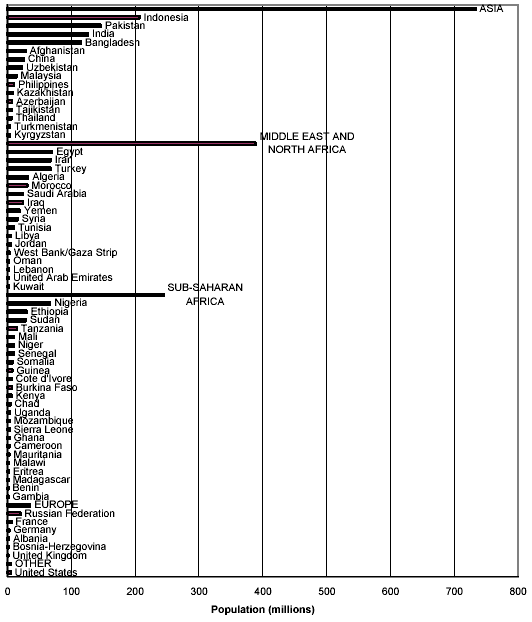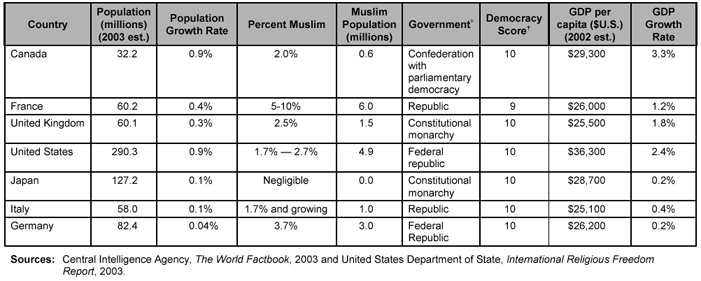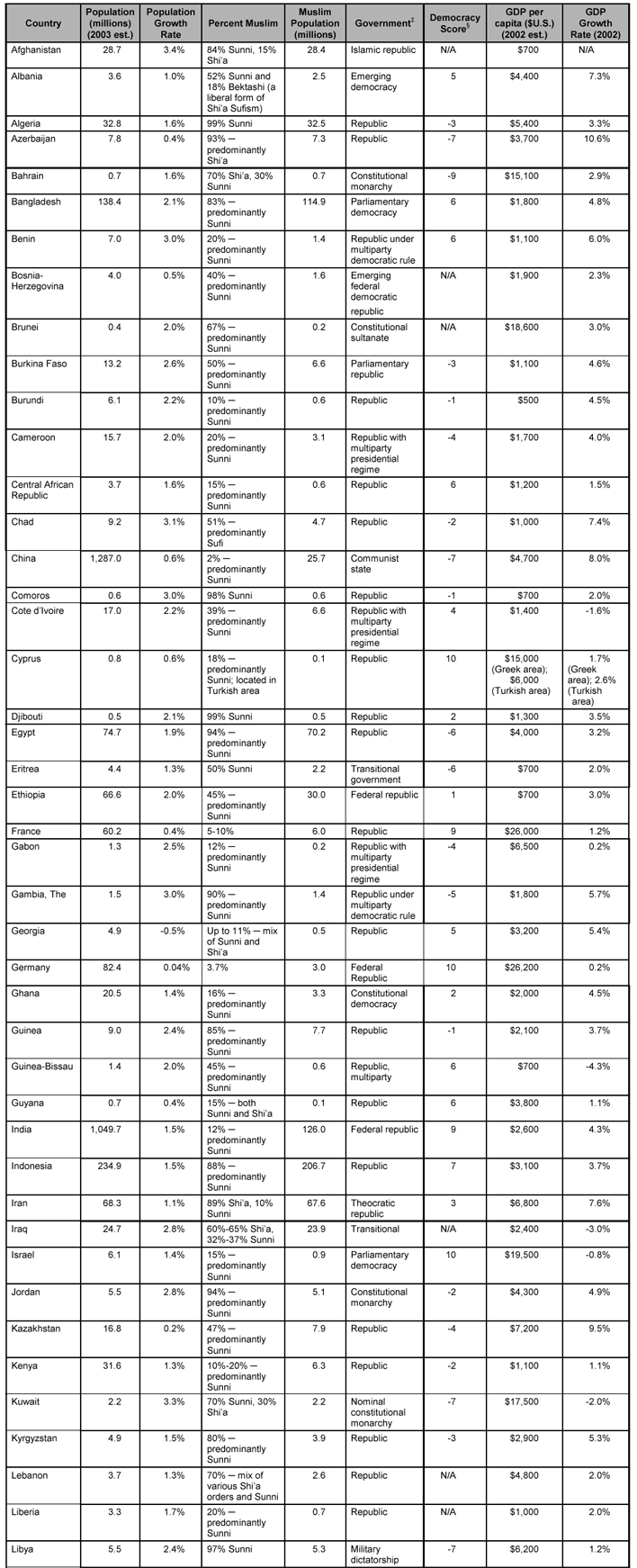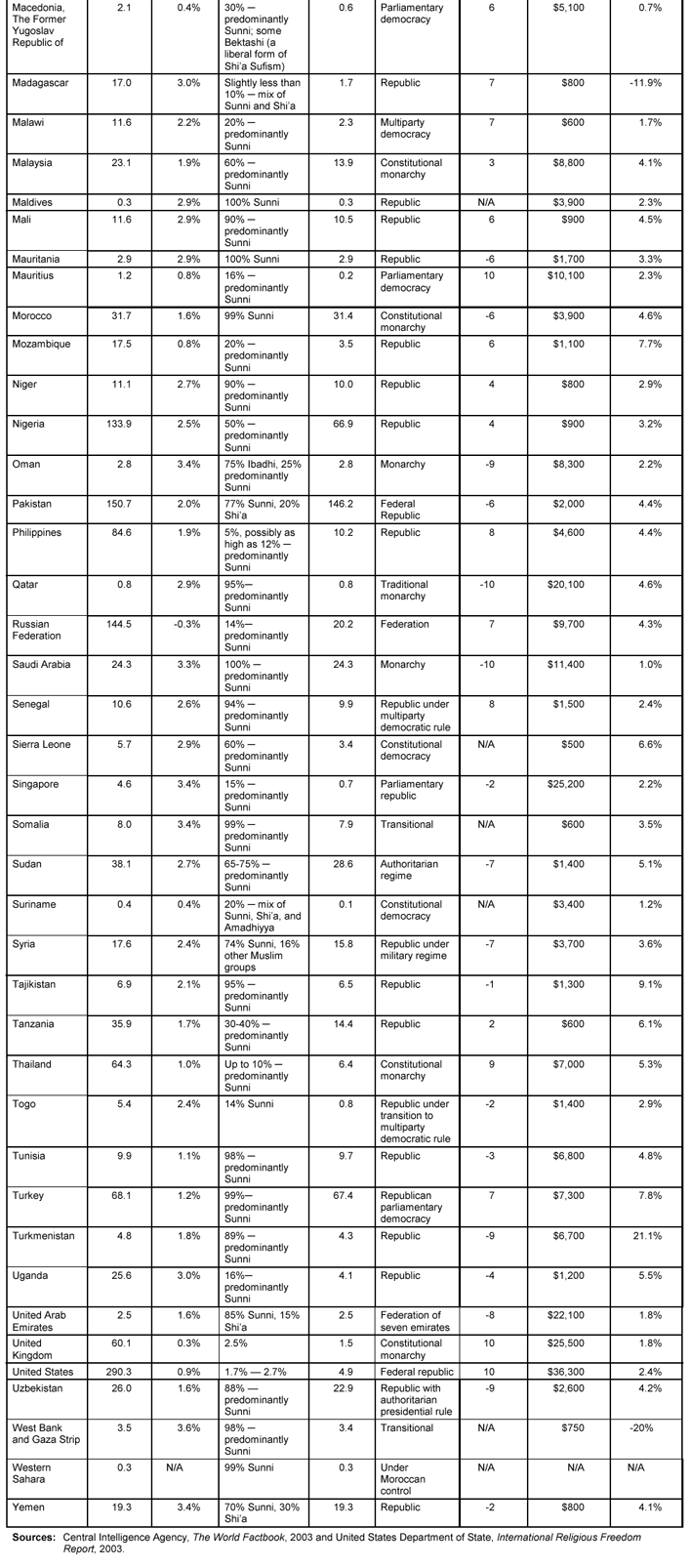FAAE Committee Report
If you have any questions or comments regarding the accessibility of this publication, please contact us at accessible@parl.gc.ca.
This profile of the “Muslim world” provides information on population, type of government, and Gross Domestic Product (GDP) for countries in which Muslims make up a minimum of 10% of the population or they number over one million. It was compiled using figures from the Central Intelligence Agency (CIA) World Factbook 2003443, the United States Department of State International Religious Freedom Report for 2003444, and the United Nations Development Programme Human Development Report 2002.
Table I gives regional445 totals and averages, adding to a world total of over 1.4 billion followers of Islam.446 Chart I shows the relative size of the Muslim population of the different regions, as well as of the countries with more than one million Muslims. For comparative purposes, figures for the G7 countries are shown in Table II.447
Table III provides the detailed list of countries. It gives figures for:
| • | the estimated total population in 2003; | |
| • | the estimated population growth rate in 2003; | |
| • | percentage of the population that is Muslim, showing the percent of the population that is Sunni, Shi’a, or, in some instances, follows other forms of Islam; | |
| • | the Muslim population, calculated by multiplying the total population by the percentage that is Muslim (where there is a range, the higher percentage was used); | |
| • | the type of government; | |
| • | the “Democracy Score”448, which rates countries on the presence of institutional factors necessary for democracy using a scale that goes from –10 (authoritarian) to 10 (democratic); | |
| • | the GDP per capita (purchasing power parity) in U.S. dollars for the year 2002; | |
| • | the GDP growth rate in 2002. |
It should be noted that the figures for Muslim populations are estimates, as are the proportions of the Muslim population that are Sunni or Shi’a. As well, the tables do not show the various subdivisions within these sects nor, with some exceptions, other forms of Islam. Followers of other forms are noted where they form a significant part of the population — the Sufi (followers of Sufism, a mystical form of Islam) in Chad, the Bektashi (a liberal form of Shi’a Sufism) in Albania and the former Yugoslav Republic of Macedonia, the Ibadhi (a distinct sect) in Oman, and the Amadhiyya (a contemporary messianic movement) in Suriname.
TABLE I
Regional Totals of Countries with a Muslim Population Greater than 10 Percent or in Excess of One Million
|
Region449 |
Population |
Average Population Growth Rate |
Total Muslim Population |
Average GDP per capita ($U.S.) |
Average GDP Growth Rate |
|
Asia |
3,139.9 |
1.6% |
733.1 |
$6,035 |
6.0% |
|
Middle East and North Africa |
405.5 |
2.2% |
388.8 |
$8,626 |
1.7% |
|
Sub-Saharan Africa |
547.9 |
2.3% |
244.1 |
$1,269 |
2.9% |
|
Europe |
356.8 |
0.3% |
35.5 |
$14,114 |
2.5% |
|
Other |
127.2 |
0.6% |
5.1 |
$14,500 |
1.6% |
|
World |
4,451.4 |
1.4% |
1,406.6 |
$8,909 |
2.9% |
Source: Table III.
Chart I
Countries with a Muslim Population in Excess of One Million,
with Regional Totals

Source: Table III.
Note: The regional totals also include countries with Muslim populations greater than 10%.
TABLE II
Muslim Population in G7 Countries

TABLE III
Countries with a Muslim Population Greater than 10 Percent or in Excess of One Million


| 443 | http://www.odci.gov/cia/publications/factbook/index.html |
| 444 | http://www.state.gov/g/drl/rls/irf/2003/index.htm. |
| 445 | “Asia” includes the former Soviet Central Asian states, Azerbaijan, and Georgia. “Europe” includes all of the Russian Federation. “Middle East and North Africa” includes Cyprus, Turkey, Iraq, and Iran. |
| 446 | This number errs on the high side. The Central Intelligence Agency World Factbook 2003 puts the figure at 1.24 billion. |
| 447 | France, Germany, the United Kingdom, and the United States are also listed in Table III because each has more than one million Muslims. |
| 448 | The “Democracy Score” is taken from the United Nations Development Programme Human Development Report 2002. It is called the “polity score” in Table A1.1 of the report. |
| 449 | “Asia” includes the former Soviet Central Asian states, Azerbaijan, and Georgia. “Europe” includes all of the Russian Federation. “Middle East and North Africa” includes Cyprus, Turkey, Iraq, and Iran. |
| * | As described in the CIA World Factbook, 2003. |
| † | The “Democracy Score” is taken from the United Nations Development Programme Human Development Report 2002. The democracy score — called the “polity score” in Table A1.1 of the report, reflects the presence of institutional factors necessary for democracy. Scores range for –10 (authoritarian) to 10 (democratic). |
| ‡ | As described in the CIA World Factbook, 2003. |
| § | The “Democracy Score” is taken from the United Nations Development Programme Human Development Report 2002. The democracy score — called the “polity score” in Table A1.1 of the report, reflects the presence of institutional factors necessary for democracy. Scores range for –10 (authoritarian) to 10 (democratic). |